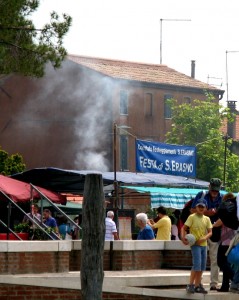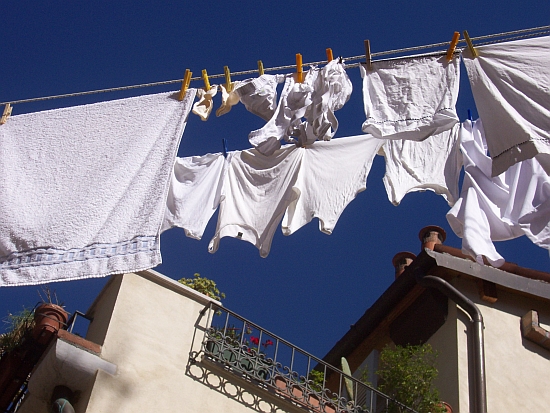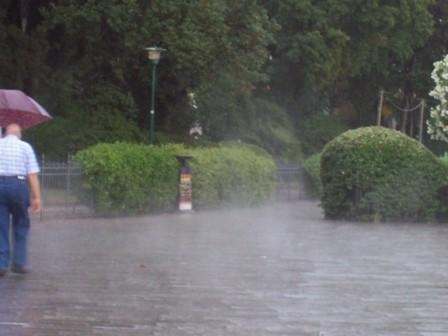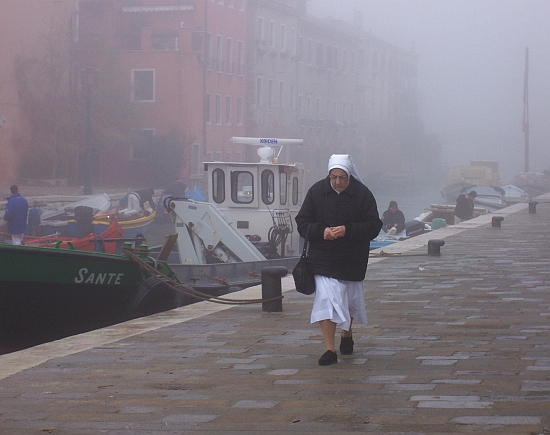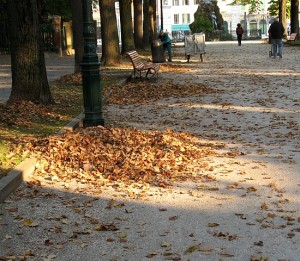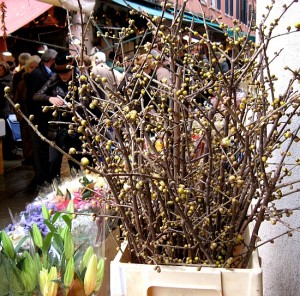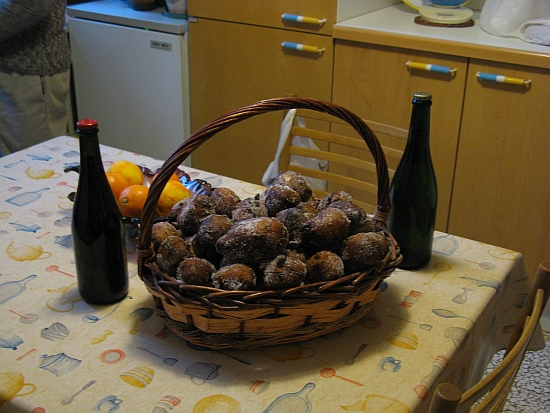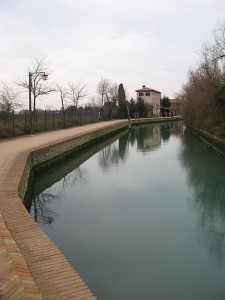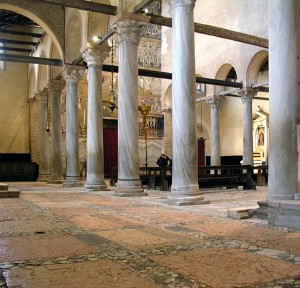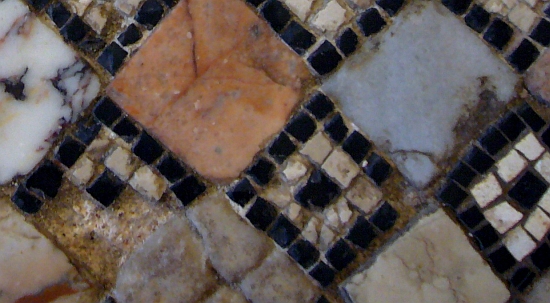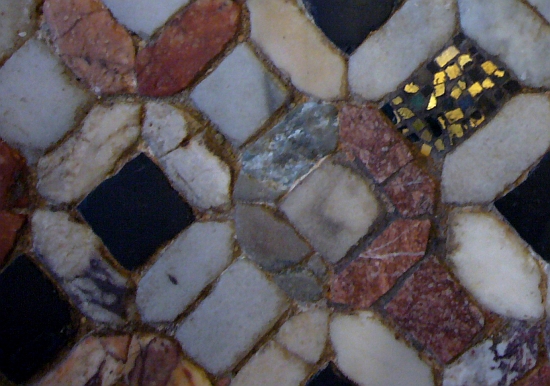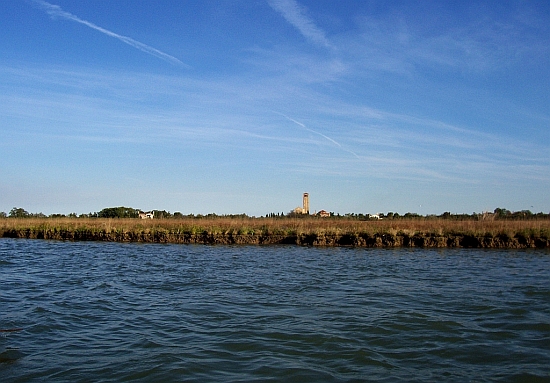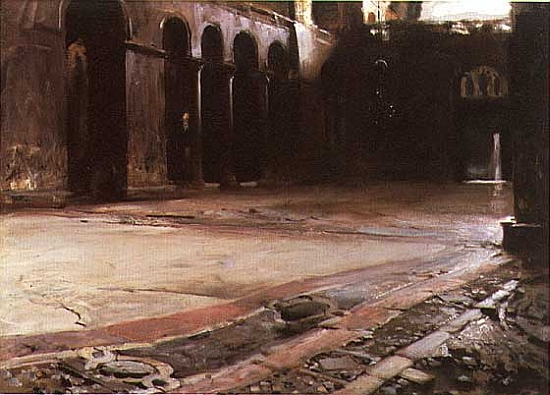I know what you’re thinking. You’re thinking of what immediately precedes a flushing sound.
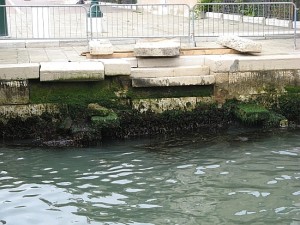
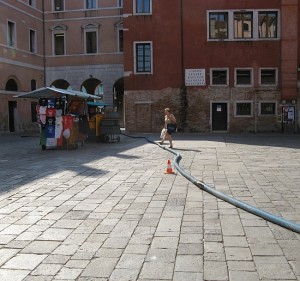
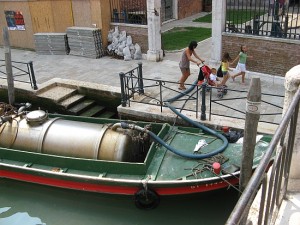
Furthermore, I invite you to consider some of the daily smells in your average mainland city: The perfume of imperfectly combusted diesel wafting from buses waiting at traffic lights, for instance, or your overflowing dumpster under the sun. I’m not saying I prefer the stench of sewage – there, I said it – I’m just saying there is no city that smells entirely of lavender potpourri.
And another thing. Before someone Beyond the Bridge starts imagining what the objectionable smells might be out here, they ought to include in that list the much more frequent AND PREVENTABLE odor that too many people — tourists or otherwise — emit from their underarms on crowded vaporettos and buses in the summer. The fact that many of them (usually men, sorry) are clinging for support to something overhead just makes it worse. Often their shirts have no sleeves.
Continuing our sensual tour of Venice — or, as I think of it, enjoying Venice with your eyes closed — I’m going to state that smell may well be the sense that gives me the most pleasure here. A random walk with your nose attuned will almost certainly awaken you to either an activity, or a product, or a season, or a plant, or something defying categorization that is something that makes Venice beautiful.
Clean laundry. I realize that anyone just walking around the city isn’t likely to be able to inhale this exquisite aroma (though one blithe spirit in Cannaregio was recently discovered at night stealing somebody’s laundry off the line, for reasons that were never very clear.) But if you are here in the summer and in a position to wash some piece of fabric and hang it out to dry, you’ll have the pleasure of inhaling the air of Venice toasted by the sun. There is no product you can put in a clothes dryer that could ever match the perfume created by the sun and the breeze, not even if it were something labeled “Venetian Sun and Breeze.”
Yes, it’s tiresome to have to calculate the time needed to dry your clothes outside on the line, especially because that time may not be quite enough to get the job done. Then you have a little psychological struggle to decide whether that sheet is really dry, or if you just wish, really hard, that it were, because it has to be. But those are details. This is one of the best smells in the world and I suppose one of the few Venetian ones you could replicate wherever you live, if your neighbors didn’t care, which they probably do.
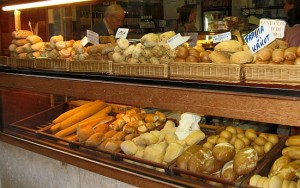
Fresh bread. If you have never, or not for a long time, walked into or past a bakery really early in the morning, when large batches of bread have just been taken out of the ovens, you might think that this is just another aroma, one of those few that humans are able to detect. (Bloodhounds, if you care, have noses that are ten- to one hundred million times more sensitive than a human’s. And bears are seven times more sensitive than bloodhounds. Just to give some perspective.) Is it the yeast? The flour? The profound need of nourishment that our primitive organism requires? Warm bread. The limbic system rejoices even if you don’t happen to be hungry.
There are 33 streets in Venice either named “baker,” “bakery” or “bakeries” (forner, forno, forni), the word denoting strictly bread, as opposed to eclairs or cake or muffins or anything else. (When I try to imagine what an average neighborhood in Venice smelled like in the year 1200 — apart from whatever the horses, humans, and roaming pigs contributed — I have to imagine the waftage from that many bakeries. Not so bad.) When First Crusader Godfreyof Bouillon set about founding the Kingdom of Jerusalem in 1099, he promised the Venetians that in exchange for their help in his little effort, in every city they conquered their merchants would have their own neighborhood containing “A street, a square, a church, a bath, and a bakery.” All the essentials, though I’d have started the list with a bakery.
One of my earliest encounters with this celestial aroma and its effect on me was in the dark of a winter dawn, when we were out rowing. We were headed south along the lagoon shore of the Lido, toward Malamocco, and my attention was mainly on the fact that there was so much fog that I could barely see where we were going. Suddenly I found myself in an invisible billow of warm-bread smell, drifting from a bakery somewhere behind the trees. It was beyond magical. And then it was gone, and we were back in the chilly, gunmetal gray world.
“Our daily bread” — it still means something here.
Pastry. Walk past certain corners early in the morning — especially Sunday morning — and you will pass through a delectable little cloud composed of the smell of warm butter and sugar. Come to think of it, I never notice any vanilla or almond or cinnamon tones, though you would expect them. It’s essentially just butter and caramelizing sugar that are doing the work and the aroma is as gorgeous as a bouquet of peonies. On a humbler note, you have an even better chance of smelling hot croissants just out of the oven of many bars and cafes — sweet, buttery, crusty. (I maintain that “crusty” is a smell.) Hardly anybody makes their own anymore; they buy them frozen. But the smell is delectable just the same.
Anything burning. Obviously I’m not referring to houses or boats here, though I think an incinerated plastic-resin boat (which I’ve seen from afar) must emit a smell that’s truly scary. And harmful.
Then there is the smoke from the motors on boats. This is, if possible, even more vile. There’s more of it, and it seems to contain 97 extra poisonous ingredients. Cruddy little boats backing up, big bruising barges stopping suddenly with a roar of the retro-rockets, and an assortment of geriatric motors belonging to men who grew up with the notion that it needs to “warm up” for ten or 15 minutes before departure. Like the old black and white TVs.
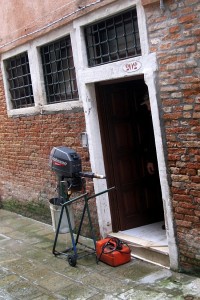
And there are motors which have been removed from their boats. The man who lives across the street (about six feet away), conducted a late-autumn ritual the other day by putting his outboard motor onto a sort of metal trolley so he could clean it out by combusting all its fuel before putting it away for the winter. So the motor stood there for a good 20 minutes, roaring, excreting thick grey smoke. Of course this is against the law. I closed the windows.
I’ve often mentioned the allure of distant woodsmoke (another smoky smell that doesn’t make any fireman feel warm and cozy). I’m really thinking about food.
The aroma of cooking comestibles could be pork ribs over charcoal (at several saint’s-day festivals), or a batch of chestnuts (Lino does this at home, though I don’t detect anyone else doing it), or anything fishy –seppoline or grey mullet or sardines on the skillet. I’ve developed sufficiently to be able to tell the difference if I’m downwind of some intrepid cook. Mostly that would be Lino. I think people generally boil or bake fish because of the smell, though sometimes I walk through the cloud of somebody else’s imminent lunch or dinner.
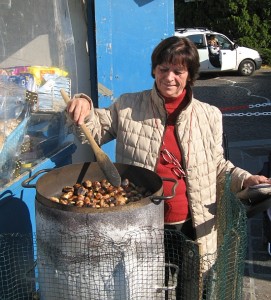
When Lino was a lad, the smell of fish of any sort crisping up on a sheet of hot metal was one of the most normal smells around, so normal that people probably didn’t even notice it. Now it’s something that inspires comment, via voices like the ones I heard out the bedroom window from people passing in the street as we were scorching a batch of the little critters. If the people are past a certain age, their comments will be smoking with appreciation and desire. If not, the heck with them. Our onlycontribution to good will among men is to avoid cooking them when people have hung their laundry out to dry just above us, because we open the windows and much as I love fish, even I wouldn’t want my underwear to smell like foodsmoke.
The fish smells vary by season. Seppie (cuttlefish) are in the fall (migrating adults) and spring (their babies). Baby seppie (seppoline), as opposed to bass or shrimp, have some extra element that comes out on the griddle, maybe because they don’t have scales. I don’t know. It’s a slightly acrid, slightly salty, slightly bitter scent. It’s a fragrance that seems to connote a party, or at least a small but chaotic family gathering.
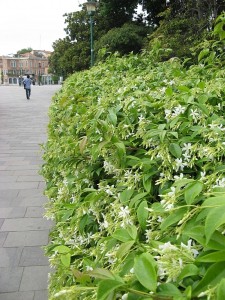
Flowers. In April and May Venetian flora goes berserk. Festoons of wisteria, then the magnolia blossoms, then dense bushes of jasmine andpittosporum saturate the air with a fragrance so powerful it verges on nauseating. (I said “verges.”)
Followed immediately, in early June, by the flowering of the lime, or linden, trees. I never knew this smell before coming here, and it is absolutely the most wonderful plant-perfume here (exception made for calicanthus).
I don’t need to see the linden blossoms, it’s enough for me to inhale their perfume, an exquisite mingling of delicate, not-too-sweet, utterly seductive elements. Somebody knows what they are and what they’re called, but I’m not interested. I just want to breathe it all in while I can. It doesn’t last as long as I’d like it to — maybe ten days. I’d willingly shift some of the time the jasmine hangs around and give it to the lime trees.

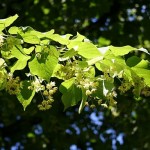
- It had been so hot for so long that the rain had hardly begun to fall before we were walking through a Turkish bath.
Rain. The summer sun beats down on the masegni, or paving stones, day after day, and nobody notices until it rains. Especially if the rain isn’t very hard or heavy, the superheated blocks of trachyte release a mist of steam (usually invisible, though not always) that smells of equal parts water and stone. It smells of cool, it smells of relaxation. It must stimulate that little part of the brain that responds to the word “oasis” or “waterfall.”
- Fog definitely has its own smell. It’s something sharply clean and faintly metallic, something resembling wet iron. Being hot augments the rain smell; being cold augment
Coffee. In the 17th century, an Arab judge, Hadjibun di Medina, was instructed by the Ottoman sultan to settle some social controversy concerning the benefits of coffee. (There was one intrepid subject who felt about coffee the way I feel about smoke, which created some temporary controversy.) The good Hadjibun issued this statement: “Oh you men of open mind, drink coffee and don’t pay any attention to the detractors who with denigrate it with brazen lies. Drink it generously because its aroma banishes worries, and its fire reduces to ashes the turbid thoughts produced by daily life.”
As my thoughts are dangerously prone to becoming turbid it’s a good thing there’s so much good java around. Even a whiff as I pass certain cafes on my daily rounds is an ethereal encouragement. Which keeps me going till I pass the next cafe.
